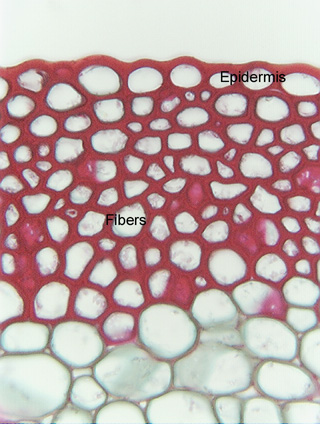 Fig.
10.2-8. Transverse section of stem of rush (Juncus). The stems
of rushes are persistent, not ephemeral, and have a thick layer of fibers just
below the epidermis. It would be possible to have a parenchymatous epidermis
above a mass of fibers, but in this species, the epidermis
cells also convert to sclerenchyma cells. Both the lignin and the
cutin have stained a uniform red here, so it is not possible to see if the
cuticle is thick. Of course, guard cells must not sclerify if they are to remain
responsive.
Fig.
10.2-8. Transverse section of stem of rush (Juncus). The stems
of rushes are persistent, not ephemeral, and have a thick layer of fibers just
below the epidermis. It would be possible to have a parenchymatous epidermis
above a mass of fibers, but in this species, the epidermis
cells also convert to sclerenchyma cells. Both the lignin and the
cutin have stained a uniform red here, so it is not possible to see if the
cuticle is thick. Of course, guard cells must not sclerify if they are to remain
responsive.